When you picture a penguin in your mind, most people will think of them as living in the cold polar ice caps. But, you might be surprised to find out that they can live in all sorts of climates. So, where do penguins live?
Penguins live in the southern hemisphere. There are 18 different species, each with a different geographic range that includes Antarctica, sub-Antarctic islands, South America, Africa, Australia, and New Zealand. The largest populations are in Antarctica, although they are not confined to cold places as many people think.
Keep reading to find out more about the geographic range and habitat of each species along with maps for type. If you want to learn more about these fascinating creatures, see our list of penguin facts for more information.
- Map of Where Penguins Live
- Where Do Penguins Live?
- Royal Penguins
- Emperor Penguins
- Adelie Penguins
- Humboldt Penguins
- Fiordland Penguins
- Magellanic Penguins
- Yellow-Eyed Penguins
- Snares Penguins
- Macaroni Penguins
- Galapagos Penguins
- Erect-Crested Penguins
- African Penguins
- Chinstrap Penguins
- King Penguins
- Gentoo Penguins
- Little Penguins
- Northern Rockhopper Penguins
- Southern Rockhopper Penguins
- Penguin Species by Country
- Why Don’t Penguins Live In The Arctic?
- Which Places Do Penguins Live in the Wild?
- Do Penguins Live in Hot Places as well as Cold Places?
- Where Do Penguins Live in Antarctica?
- Do Penguins Live at the South Pole?
- Where Do Penguins Live in South America?
- Where Do Penguins Originate From?
- Do or Could Penguins Live In The Northern Hemisphere?
- Related Questions
Map of Where Penguins Live
This world map gives a brief overview of the main breeding ground for each type of penguin. Keep reading below for individual maps for each species.

Where Do Penguins Live?
Each species has its own geographical range across the southern hemisphere, let’s take a look at them one by one (data referenced below comes from the IUCN).
Royal Penguins
The Royal Penguin is endemic to Macquarie Island and nearby Bishop and Clerk Islands which all sit about halfway between Australia and New Zealand. They are also found in small numbers on other sub-Antarctic islands such as South Georgia and Kerguelen Island.

Emperor Penguins
Emperor Penguins are found along the entire coastline of Antarctica with the largest populations in the Ross Sea and Weddell Sea. They breed on seasonal sea ice which forms around the continent in the winter but they face a reduced habitat in the future due to climate change.
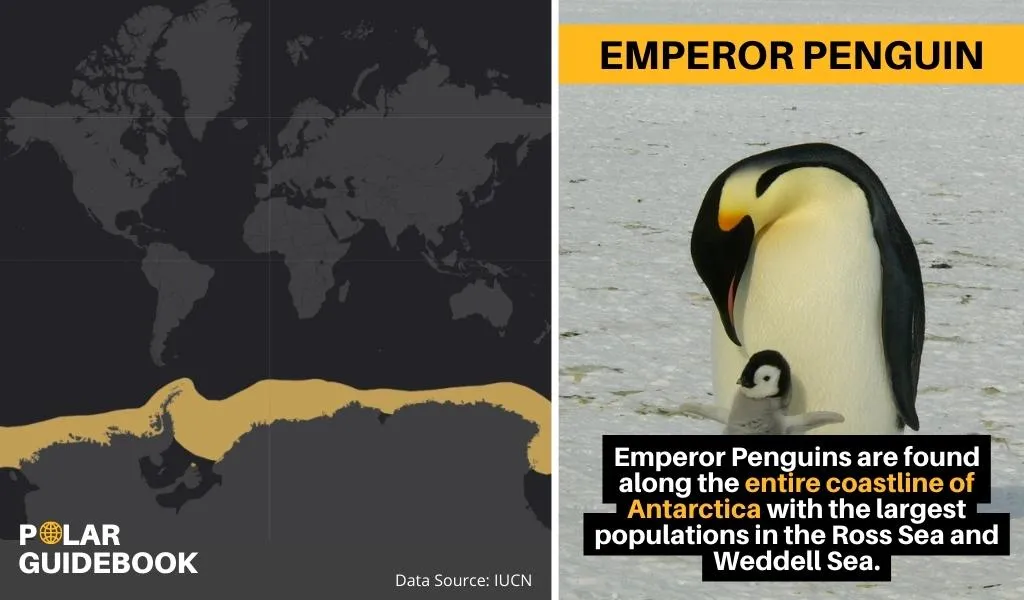
Adelie Penguins
Adelie Penguins are found along the Antarctic coastline and nearby islands including South Georgia and the South Sandwich Islands.
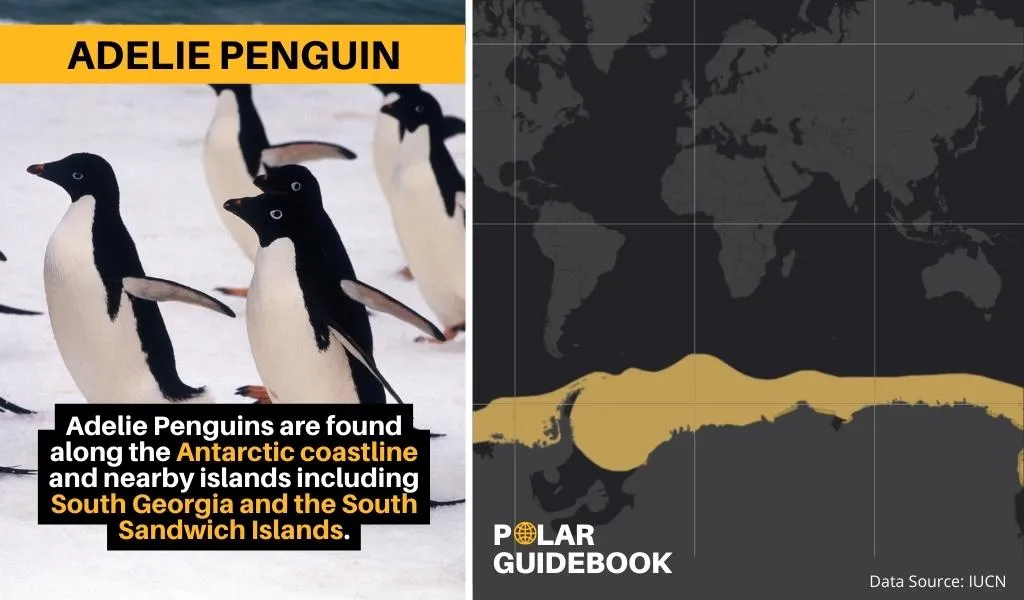
Humboldt Penguins
Humboldt Penguins are found along the pacific west coast of South America, from Isla Foca in Peru down to Isla Guafo in southern Chile.

Fiordland Penguins
Fiordland Penguins are endemic to New Zealand. On the mainland, they nest on the southwest coast of the South Island, from Bruce Bay to Coal Island. They are also found on offshore islands including Solander Island, Codfish Island, and Stewart Island.

Magellanic Penguins
The Magellanic Penguin can be found on both the Atlantic (east) and Pacific (west) coasts of South America in Argentina, Chile, and the Falkland Islands. During winter, those on the Atlantic coast migrate to northern Argentina, Uruguay, and southern Brazil. These are the longest-living penguins with a lifespan of around 30 years.

Yellow-Eyed Penguins
The Yellow-Eyed Penguin is endemic to New Zealand. They breed on the southeast coast of the South Island and nearby Stewart Island. They also inhabit some sub-antarctic islands which include the Auckland Islands and Campbell Island.

Snares Penguins
The Snares Penguin can be found on The Snares Islands, a small group of islands about 200km south of New Zealand.

Macaroni Penguins
The Macaroni Penguin breeds in southern Chile, the Falkland Islands, the Antarctic Peninsula, and many sub-Antarctic islands. The largest populations can be found at Isles Crozet (2.2m pairs), Kerguelen (1.8m pairs), Heard Island (1m pairs), South Georgia (1m pairs), and Marion Island (290,000 pairs).

Galapagos Penguins
The Galapagos Penguin is only found in the Galapagos Islands, an archipelago of 127 islands that lies around 1000km from Ecuador. The Galapagos Penguin is the most northerly of all the penguin species since the Galapagos Islands just straddle the equator.
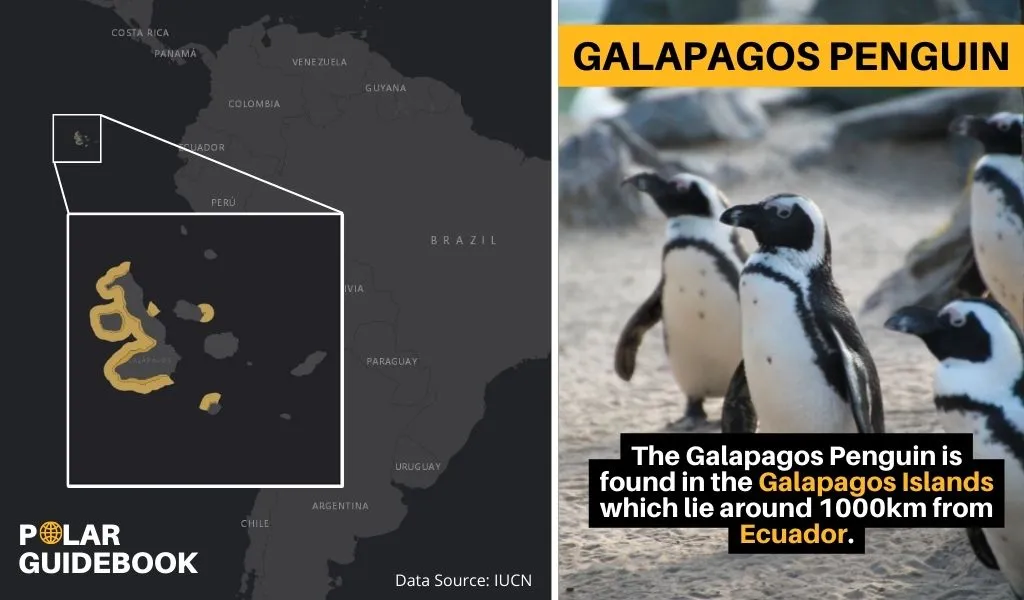
Erect-Crested Penguins
Erect-Crested Penguins are found on the Bounty Islands and the Antipodes Islands, two sets of sub-antarctic islands to the southeast of New Zealand. Outside of breeding season, they can be found on other sub-antarctic islands and the New Zealand mainland.

African Penguins
The African penguin is found along the southern coast of Africa in Namibia and South Africa. However, they have been spotted as far north as Gabon and Mozambique.
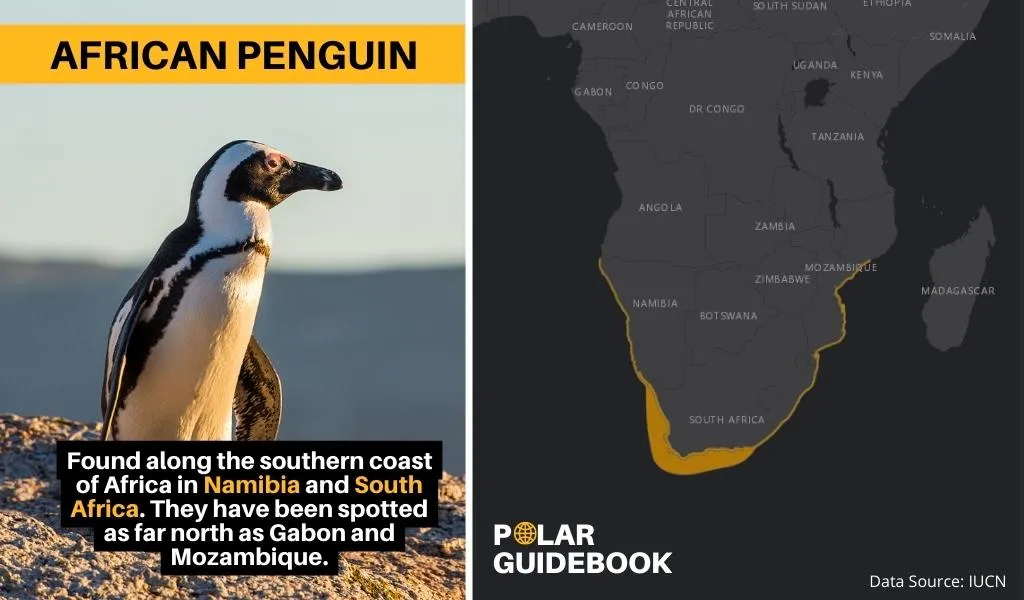
Chinstrap Penguins
The Chinstrap Penguin is found in Antarctica and islands in the sub-Antarctic region including the South Sandwich Islands, the South Orkneys, South Shetland and South Georgia, Bouvet Island and the Balleny Islands.

King Penguins
King Penguins breed on various sub-Antarctic islands between 45°S and 55°S. The largest populations are found at South Georgia (450,000), Crozet Island (377,040 pairs), and Kerguelen Island (377,000).
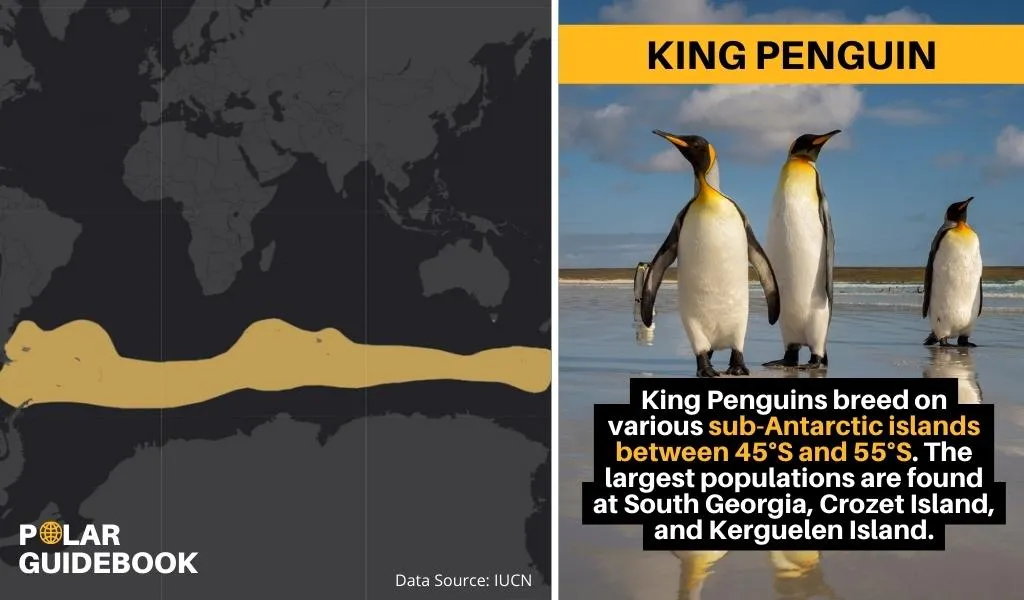
Gentoo Penguins
Gentoo Penguins are found on the Antarctic peninsular and various sub-Antarctic islands between 66°S and 46°S. Most of the population is found on the Falkland Islands (132,000 pairs), South Georgia (98,867 pairs), and the Antarctic Peninsula (94,751 pairs).

Little Penguins
The Little Penguin is endemic to Australia and New Zealand. In Australia, they are found along the southern coast and surrounding islands. In New Zealand, they are found on the mainland and nearby islands such as Chatham Islands and Stewart Island, although they are not found in Fiordland nor South Westland.

Northern Rockhopper Penguins
Northern Rockhopper Penguins are found across 7 islands in the South Atlantic and Indian oceans between 37°S and 40°S. Most of the population are found on the Tristan da Cunha archipelago and Gough Island.

Southern Rockhopper Penguins
Southern Rockhopper Penguins breed on sub-Antarctic islands in the South Atlantic, Indian, and Pacific Oceans between 46°S and 54°S including Heard Island and the McDonald Islands and Macquarie Island.

Penguin Species by Country
This table shows which penguin species live in each country. It only shows native species and may not include some vagrant species that have been spotted wandering there.
| Place | Native Species of Penguin |
|---|---|
| Angola | African (non-breeding) |
| Antarctica | Emperor (breeding), Adelie (breeding), Chinstrap (breeding), Gentoo (breeding), Southern Rockhopper (non-breeding), Macaroni (breeding) |
| Argentina | Magellanic (resident), Macaroni (breeding), King (non-breeding), Gentoo (resident), Southern Rockhopper (resident) |
| Australia | Royal (breeding), Fiordland (non-breeding), Gentoo (breeding - Macquarie Island), Little (resident), Southern Rockhopper (breeding) |
| Bouvet Island | Macaroni (breeding), Chinstrap (breeding), Gentoo (seasonality uncertain) |
| Brazil | Magellanic (non-breeding) |
| Chile | Humboldt (breeding), Magellanic (resident), Chinstrap (resident), King (non-breeding), Gentoo (non-breeding), Southern Rockhopper (resident), Macaroni (breeding) |
| Ecuador | Galapagos (resident) |
| Falkland Islands | Magellanic (breeding), Macaroni (breeding), Chinstrap (resident), King (resident), Gentoo (breeding), Southern Rockhopper (resident) |
| French Southern Territories | Macaroni (breeding), Chinstrap (resident), King (resident), Gentoo (breeding), Northern Rockhopper (breeding), Southern Rockhopper (resident) |
| Heard Island and McDonald Islands | Macaroni (breeding), King (resident), Gentoo (breeding), Southern Rockhopper (resident) |
| Mozambique | African (non-breeding) |
| Namibia | African (resident) |
| New Zealand | Fiordland (breeding), Yellow-Eyed (resident), Snares (breeding), Erect-Crested (resident), Little (resident), Northern Rockhopper (non-breeding), Southern Rockhopper (resident) |
| Peru | Humboldt (breeding), Magellanic (non-breeding) |
| South Africa | Macaroni (breeding), African (resident), King (resident), Gentoo (breeding), Northern Rockhopper (non-breeding), Southern Rockhopper (resident) |
| South Georgia and the South Sandwich Islands | Adelie (breeding), Macaroni (breeding), Chinstrap (breeding), King (resident), Gentoo (breeding), |
| Uruguay | Magellanic (non-breeding) |
Why Don’t Penguins Live In The Arctic?
Penguins don’t live in the arctic, or any part of the northern hemisphere, because there is less ocean, less of their preferred prey, and more land predators which put their eggs and chicks at risk when breeding. The impact of Human disturbance and land use is also likely to have affected penguin distribution.
Let’s look at each of these issues as to why Penguins are not found in the Northern Hemisphere in further detail:
1. Less ocean compared to the southern hemisphere.
Penguins spend 75% of their daily lives in the water and can spend months at sea outside of breeding season. This is why Antarctica, Australia, New Zealand, and many sub-Antarctic islands are perfect for them as they are surrounded by vast open waters.
The southern hemisphere is about 80% water and 20% land, whereas there is twice as much land in the northern hemisphere which is about 60% water and 40% land1 (source: Climate Science Investigations).
2. Less of their preferred prey.
Penguins mostly eat krill, these are small crustaceans that are found in all oceans in the world. There are large differences in krill abundance between different regions, however, in general, they are less abundant in Arctic waters than they are in Antarctic waters influencing why penguins are only found in the south2 (source: M. M. McBride, et al., ICES Journal of Marine Science, Vol 71, Issue 7, 2014).
3. There are more land predators.
A third factor as to why penguins don’t live north of the equator is the larger number of land predators that pose a risk to penguin eggs and young chicks than in the south. For example, foxes and bears whose territories can cover large land areas that are not separated by large expanses of water.
4. Greater risk of human interference.
In more recent history, human activity has had a large impact on penguin populations. Both directly (through fishing and harvesting their eggs, feathers, and guano) and indirectly through climate change, oil spills, and prey reduction3 (source: P.N. Trathan, et al., Conservation Biology, 29, 2015).
Given that almost 90% of humans live in the northern hemisphere4 (source: Business Insider), it’s safe to assume that this is another reason why penguins have kept well away.
Which Places Do Penguins Live in the Wild?
Here’s a list of the most well-known places that penguins live in the wild:
Antarctica
Antarctica is home to the largest population of penguins. Here, you’ll find five species of penguin; Adelie, Emperor, Chinstrap, Gentoo, and Macaroni Penguins. The State of Antarctic Penguins Report estimates that there are 5.77 million breeding pairs of penguins in Antarctica between all five species that breed here, they nest at 698 sites across the continent.
Antarctic and Sub-Antarctic Islands
Many species of penguins can be found on Antarctic islands (those south of 60°S) and Sub-Antarctic islands (those north of 60°S but biogeographically linked to Antarctica). Some popular islands for penguins include South Georgia and the South Sandwich Islands (Britain), Crozet Island (France), and Heard Island and Mcdonald Islands (Australia).
Argentina
Four species of penguin breed in Argentina; Magellanic, Macaroni, Gentoo, and Southern Rockhopper Penguins. However, it is best known for Magellanic Penguins and it’s home to the largest colony in the world, in Punta Tumbo, which can host over a million birds5 (source: Longview Daily News, 2017).
The Falkland Islands
The Falkland Islands, a group of islands about 480km (300 miles) east of South America, supports over a million penguins each breeding season6 (source: Falklands Conservation) from six species of penguin; Magellanic, Macaroni, Chinstrap, King, Gentoo, and Southern Rockhopper.
This includes the world’s largest Gentoo colony with 121,500 breeding pairs7 (source: Falklands Conservation) and to a tiny Chinstrap colony on Elephant Island with 7,000 breeding pairs8 (source: N. Strycker, Oceanographic Magazine) also found in the Falklands.
New Zealand
New Zealand has one of the most diverse penguin populations with six penguin species that breed there and one that migrates there outside of breeding season.
The six species of penguins that breed in New Zealand are Fiordland, Yellow-Eyed, Snares, Erect-Crested, Little, and Southern Rockhopper whilst Northern Rockhopper Penguins only spend time there in winter.
Three penguin species are endemic to New Zealand, meaning that they don’t breed anywhere else. These are the Snares Penguin of Snares Island, the Fiordland Penguin, and the Yellow-Eyed Penguin.
Australia
Penguins are thought to have first evolved in Australia (more on this below) so you won’t be surprised to know that there are many large and wide ranging species.
There are five species of penguins that call Australia their home and these are Royal, Gentoo, Little, and Southern Rockhopper Penguins during breeding season and Fiordland Penguins outside of breeding season. The Royal Penguin is also endemic to Australia, found only on the Australian Macquarie Island which sits halfway between Australia and New Zealand.
There are also three penguin species that are vagrant and are seasonally migratory which means that they are seen from time to time but are not native to the area and these are King, Macaroni, and Adelie Penguins9 (source: IUCN).
The Galapagos Islands
Uniquely, the Galapagos Penguin is endemic to the Galapagos Islands, a group of around 127 islands, islets, and rocks which lie about 1000km off the coast of Ecuador.
The islands sit on the equator so they are not only the most northerly penguins but one of the smallest species by population and one of the most endangered penguin species with only around 1,200 mature individuals left10 (source: IUCN).
At just 50cm (19″) tall, they are the second smallest penguin, beaten only by the Little Penguin11 (source: The Illustrated Encyclopaedia of Birds: Definitive Guide to Birds of the World, Dr. Christopher M. Perrins, 1999).
Do Penguins Live in Hot Places as well as Cold Places?
Yes, some species of penguin live in hot places, these are the Little Penguin and those that fall into the group of banded penguins (Spheniscus) which includes Magellanic, Humboldt, Galapagos, and African Penguins.
These penguins are better adapted to warm environments and for example, they are typically much smaller than Antarctic penguins (See our full comparison of penguin sizes by species). This means that they have a higher surface area relative to their overall body mass for heat regulation.
They also change their behavior to adapt to the warmth. Most will build their nests in burrows for protection against the heat of the sun and will spend large parts of the day in them12 (source: A. Chiaradia, Interpretive Birding Bulletin, Vol. 5, No. 3, 2001).
To cool down, penguins in hot places will also keep their feet in the shade of their body by leaning forward and will spread their flippers out wide, allowing excess heat to escape from the underside.
Where Do Penguins Live in Antarctica?
There are five species of penguins that are found in Antarctica during breeding season, these are Adelie, Emperor, Chinstrap, Gentoo, and Macaroni.
Adelie and Emperor Penguins only breed in Antarctica and can be found across the whole continent including the Peninsular, Ross Sea, and East Antarctica. Whereas Chinstrap, Gentoo, and Macaroni Penguins only breed on the Antarctic Peninsular13 (source: Oceanites, State of Antarctic Penguins Report, 2020).
Penguins that live in Antarctica have behavioral traits and adaptations that help them survive the cold. for example, they are generally much bigger, have cold-blooded feet, and huddle together for warmth.
More than half of the penguins in Antarctica live on the Antarctic Peninsular (53.7%) with the remainder are split across the Ross Sea (27.0%) and East Antarctica (19.9%).

Whilst Adelie and Emperor Penguins are true Antarctic penguins that only breed on the continent, Chinstrap, Gentoo, and Macaroni Penguins also breed further north on other sub-Antarctic islands and some populations can even be found as far north as the Falkland Islands and southern Chile.
Do Penguins Live at the South Pole?
We’ve all seen cartoons depicting penguins at the south pole, but just how accurate is this? To answer this, let’s first understand where the south pole actually is.
The geographic south pole, or the ceremonial south pole, sits at the southern end of the Earth’s axis and receives 6 months of day and 6 months of night each year. This image shows the location on a map of Antarctica, the red line is the South Pole Traverse which links the US south pole research station to their McMurdo station on the coast, this route is 1,601km (995 miles) long14 (source: Wikipedia).

There are no penguins at the south pole because they inhabit coastal areas whereas the south pole is about 1,300km (810 miles) from the nearest open sea at the Bay of Whales. When penguins aren’t incubating eggs, penguins must regularly travel to the sea for food so the distance from the south pole to the sea would be too far for them to travel which is why they are not technically found at the south pole.
Where Do Penguins Live in South America?
In South America, penguins can be found living in coastal regions of Argentina, Peru, Chile, Ecuador, and the Falkland Islands. The largest populations of the most common penguin species are found in Argentina but outside of breeding season, Magellanic penguins can also be found in Brazil and Uruguay.
As many as eight species of penguin can be found in South America, these include Magellanic, Chinstrap, Humboldt, Macaroni, King, Gentoo, Southern Rockhopper, and Galapagos Penguins.
However, Humboldt Penguins are best found along the South Atlantic Coast, Magellanic Penguins around both the Atlantic and Pacific Coasts, and Galapagos Penguins (endemic to the Galapagos Islands) off the coast of Ecuador.
Where Do Penguins Originate From?
Contrary to popular belief, penguins originated in New Zealand and Australia around 22 million years ago, not in Antarctica.
A 2020 study looked at DNA samples from all 18 penguin species currently in existence and concluded that penguins (ancestors of the King and Emperor Penguins) were the first to diverge when they traveled to Antarctica most likely attracted by abundant food.
This is why King and Emperor Penguins are often considered to be a ‘sister group’ to all other penguins. Evidence then suggests that when the Drake Passage (between South America and Antarctica) opened up around 12 million years ago, penguins were able to travel much further and the other species began to evolve.
Do or Could Penguins Live In The Northern Hemisphere?
No, penguins are not found natively in the wild in the northern hemisphere although they can be found in zoos across the world.
There have been two attempts to introduce penguins to the arctic in 1936 and 193815 (source: P. Roberts and D. Jørgensen, Journal for the History of Environment and Society, Vol. 1, 2016). These attempts by Adolf Hoel of the Norwegian Polar Institute and Norweigan shipowner Lars Christensen were largely driven by economic and political reasons.
Their first attempt saw nine penguins introduced to the Lofoten Islands and mainland Norway in 1936, however, the birds would not remain where they had been released and some were shot by local people who did not support the introduction.
For the second attempt in 1938, the plan was to acclimatize 60 penguins in captivity in Røst and then release them. However, the penguins did not fare well during their time in captivity and were released too early. Again, the attempt did not go well and the last sighting of a penguin in the wild in Norway was in 1953.
Related Questions
What Biome Do Penguins Live in?
A biome is an area classed and characterized by the species that live within it. Penguins are best known for living in the Antarctic tundra biome which is where the largest populations can be found.
However, they can be found in many different biomes across the southern hemisphere from the sub-tropical biome in New Zealand to the desert biome in parts of Africa and South America16 (source: Wikipedia).
Where Do Penguins Live In Africa?
The only penguin species that lives in Africa is the African Penguin which breeds along the southern coast. The majority of African Penguins live in South Africa (13,000 pairs) and Namibia (5,700-5,800 pairs) although they have also been seen further north as far as Gabon and Mozambique17 (source: IUCN).
Where Do Emperor Penguins Live?
Emperor Penguins are only found in Antarctica where they breed in coastal areas around the entire continent. There are about 54 colonies of Emperor Penguin with the largest ones around the Ross Sea and Weddell Sea areas18 (source: IUCN).
Where Do Penguins Sleep?
Penguins have a polyphasic sleep pattern which means they get their sleep as many small naps throughout the day and night rather than one longer sleep like humans. These naps are typically less than 10 minutes at a time and they can be taken whilst standing up on land with their beak tucked into their flipper or whilst in the water.
Find out more about the sleep patterns of penguins in our full article on how penguins sleep.
Where Do Penguins Live Besides Antarctica?
Besides Antarctica, penguins also live on every other continent in the southern hemisphere including South America, Africa, and Australia. They do not live in the wild in Europe, Asia, or North America.
Do Penguins Live in Igloos?
No, igloos are made from blocks of ice which are made by indigenous people. Since penguins only have wings, they would not be able to build igloos. Also, Igloos are typically found in the Arctic which is in the northern hemisphere where indigenous populations live, since penguins only live in the hemisphere, they are not able to live in these igloos.
Do Penguins Live in Burrows?
Yes, 5 out of 18 species of penguins are known to build their nests in burrows. These are the species that are found furthest north and include Little, Magellanic, Galapagos, African, and Humboldt Penguins.
Do Penguins Live North or South Pole?
Neither, penguins do not live at either of the poles because of the location of the actual poles in relation to suitable habitats although the south pole is the closest to their actual habitat. Penguins can be found all across the southern hemisphere including Antarctica. However, they don’t live at the south pole itself as it is too far from the open water where they forage for food.
Do Penguins Live in Alaska?
No, there are no penguins in Alaska because this is in the Arctic in the northern hemisphere whereas penguins live in the southern hemisphere below the equator.

![You are currently viewing Where Do Penguins Live? [With Map]](https://polarguidebook.com/wp-content/uploads/2022/02/where-do-penguins-live-1.jpg)


